
Introduction
If you are interested in a similar article covering Gateron key switches, please check out our previous guide.
Kailh makes probably the most popular key switches, offering a wide range of designs and switch styles. They make some of the best tactile and clicky switches available, with only their linear switches falling behind Gateron for smoothness.
Anatomy of a Mechanical Key Switch
A mechanical key switch is made from only 5 parts. They are made from high precision plastic polymer with a gold-plated internal switch to ensure minimal wear and achieve a long lifespan. Many switches are rating to last between 50 million and 100 million key presses.
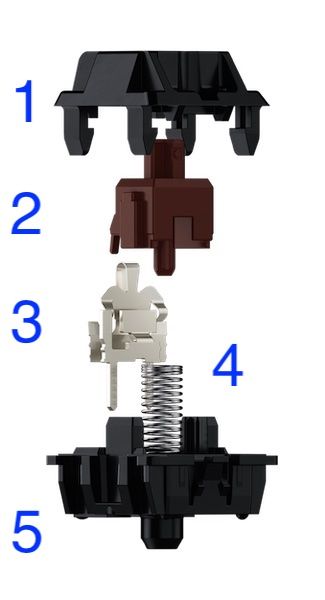
1) Upper Housing - The upper housing is made from a plastic polymer to a very high level of tolerance, guiding the stem to create a smooth vertical movement with a negligible wobble. You will notice that with very cheap keyboards, the keys feel very unstable when typing.
2) Stem - The stem is made of plastic polymer that creates the vertical movement and the key feel. For a tactile or clicky key switch, the stem is responsible for the tactile or clicky characteristics due to its unique shape and design.
3) Crosspoint Contact - Usually gold-plated, the crosspoint contact is the heart of the key switch. Using gold ensures there is no corrosion throughout the life of the switch.
4) Coil Spring - The coil spring provides the resistance you feel when you depress the key. Each switch type uses a different rated spring. You can see the effect of the spring when looking at the activation force value for each switch.
5) Base Housing - Like the upper housing, the base housing is made from a plastic polymer. The base housing both holds together the switch internal mechanism and also forms the mount with which it connects to the keyboard base.
Key Switch Terminology
Key Switch specifications
There are several terms used when comparing the specifications of a mechanical key switch.
- Activation Force - measured in grams (g) and represents the force that needs to be applied to activate the switch. A lower number gives the keyboard a lighter feel; however, you may find that these switches are activated too easily. The higher the number the harder the keys will feel. A gamer or typist prefers a balance as too high an activation force can result in finger fatigue over time.
- Bottom Out Force - measured in grams (g) and represents the force that needs to be applied to fully bottom out the switch. Many switches have a similar activation and bottom-out force resulting in a smooth resistance throughout the keystroke. If the bottom-out force is higher than the activation force the switch will feel progressively harder to press throughout the keystroke.
- Activation - measured in mm and represents the distance the key switch needs to travel before it is activated. Too little can result in keys being incorrectly activated if you are a fast typist and too high can make typing speeds slower as you need to depress each key further. Note that there is always a tolerance of around 0.6mm in these values. Some switches designed for gamers offered a reduced activation resulting in a faster response time.
- Travel - measured in mm and represents the total travel of the key switch. Most mechanical key switches have a travel of around 4mm, with some slim keyboards having reduced travel. Note that there is always a tolerance of around 0.6mm in these values. Some switches designed for gamers offered reduced travel resulting in a faster response time.
Key Switch IP Rating
Many key switches will offer an IP rating in their specifications for dust and moisture protection. For example, Cherry MX switches are rated at IP40 and Kailh at IP56. I have not been able to find any ratings specific to Gateron switches; however, would assume they are also IP40 as they closely follow the Cherry MX design. You may see a similar rating for mobile phones and smartwatches, such as the iPhone that specifies a rating of IP68. So, what do these ratings mean?
IP stands for Ingress Protection, with the IP rating number being split into 2 digits, with the first digit representing the solid protection and the second digit the liquid protection.
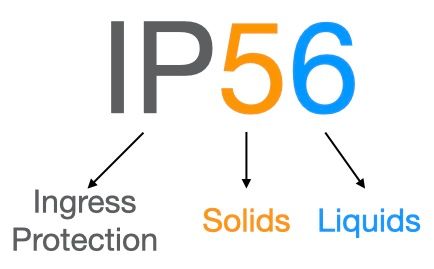
- IP40 - This rating covers most Cherry MX switches, with a solid protection rating of 4, meaning protection against solid objects larger than 1mm and a liquid protection rating of 0, meaning no rating or protection.
- IP56 - This rating covers most Kailh switches, with a solid protection rating of 5, meaning partial protection against dust and other particulates and a liquid protection rating of 6, meaning protection against powerful jets of directed water from any direction.
Even though this seems to show that Kailh is a clear winner, I would not personally read too much into this. If you do accidentally spill water onto your keyboard, I suspect the rest of the keyboard would not be that waterproof and also suffer damage. I have never had a key switch fail, but I did find it interesting to understand what these ratings mean.
History of Kailh
Ever since Cherry's patents on the MX switches expired in 2014, the market has been flooded with inexpensive clones of their key switches. Many of these are of poor quality; however, a few companies such as Gateron and Kailh have grown to offer switches that match and in many cases better the Cherry equivalents.
Kailh, or officially Dongguan Kaihua Electronics was founded in 1990. They specialise in electronic and electric switches. Whilst Kailh do manufacture clones of the original Cherry MX design, they have also developed several unique designs themselves, such as with their BOX design.
Kailh Key Switch Designs
Kailh Standard Cherry MX Switches
These are the most basic Kailh switches and closely resemble the corresponding Cherry MX or Gateron switches. I would recommend you look beyond these in favour of the Kailh Box switches. The box design offers a smoother feel with less keycap wobble due to the design of the stem.
Kailh standard key switches feature a 50 million actuation lifetime.
Kailh Box Key Switches
These switches feature a unique box design to the stem. This keeps the stem protected to provide an IP56 rating for dust and moisture and also reduces any keycap wobble.
Note that the Kailh Box key switches are only compatible with SMD LEDs rather than the through-hole LEDs due to the IP56 water-resistant construction. They have slightly less travel (3.6mm) and activation (1.8mm) than standard MX switches (typically 4mm and 2mm respectively.) The design includes a hole on the bottom of the switch, meaning that they cannot be easily lubed without the chance of lube leaking out. I did read that Kailh will be retooling their switches to remove the hole.
All Kailh Box key switches feature an 80 million actuation lifetime.
Kailh has released such a large number of Box switches, especially the clicky variety, that it can be hard to differentiate between many of them. In addition, Kailh also has several collaborations with mechanical keyboard specialists such as NovelKeys that result in even more variations.
Kailh Speed Switches
Similar to the Cherry MX Speed switches, these are designed with a higher activation point of only 1.1mm compared to 2.2mm of other Kailh switches.
Kailh Pro Switches
The Kailh Pro range of switches is listed as Kailh’s more professional and higher-end models. They do not feature the Kailh Box design and I found they do have slightly more keycap wobble.
Kailh Linear Key Switches
Linear key switches are popular for gaming, where the smooth travel of the keys minimises any finger fatigue due to fast and intensive key presses.
| Key Switch | Activation Force | Activation | Travel |
|---|---|---|---|
| Kailh Red | 50g | 2mm | 4mm |
| Kailh Black | 50g | 2mm | 4mm |
| Kailh Box Red | 45g | 1.8mm | 3.6mm |
| Kailh Box Black | 60g | 1.8mm | 3.6mm |
| Kailh Box Silent Red | 35g | 1.8mm | 3.6mm |
| Kailh Speed Silver | 50g | 1.1mm | 3.5mm |
Kailh Red
The Kailh Red is not as good as either the Cherry MX or Gateron with a slightly scratchy feel. The Kailh Box Red is a smoother switch.
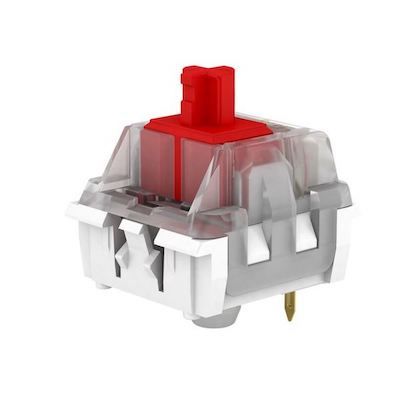
- Activation Force - 50g
- Bottom Out Force - 65g
- Activation - 2mm
- Travel - 4mm
Kailh Black
The Kailh Black is not as good as either the Cherry MX or Gateron with a slightly scratchy feel. The Kailh Box Black is a smoother switch.
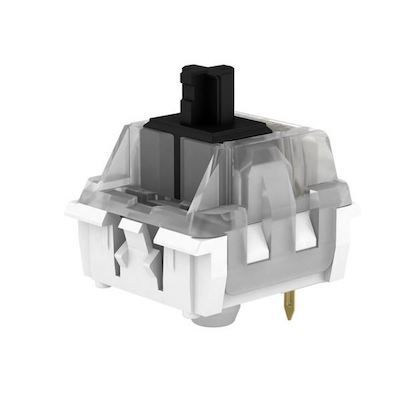
- Activation Force - 60g
- Bottom Out Force - 70g
- Activation - 2mm
- Travel - 4mm
Kailh Box Red
I find the Kailh Box Red to be more scratchy than Cherry MX or Gateron Red.
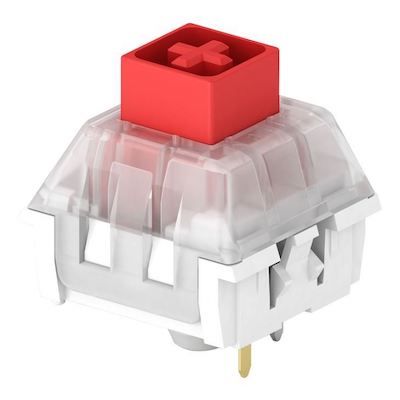
- Activation Force - 45g
- Bottom Out Force - 60g
- Activation - 1.8mm
- Travel - 3.6mm
Kailh Box Black
I find the Kailh Box Black to be more scratchy than Cherry MX or Gateron Black.
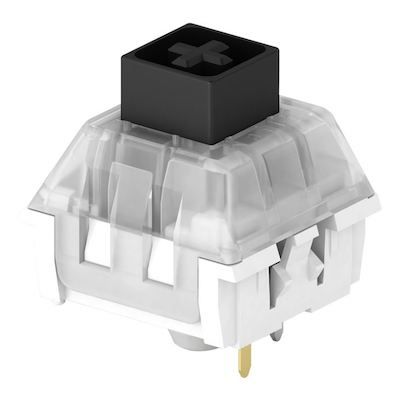
- Activation Force - 60g
- Bottom Out Force - 70g
- Activation - 1.8mm
- Travel - 3.6mm
Kailh Box Silent Red
Similar in design to the Cherry MX Silent Red, the switch includes a rubber dampener to reduce noise when they bottom out. Unlike other Box designs, the stem features a circle shape rather than a box. Interesting the stem is a bright pink colour rather than simply a lighter red on the Cherry MX. The design does increase the activations to 80 million.
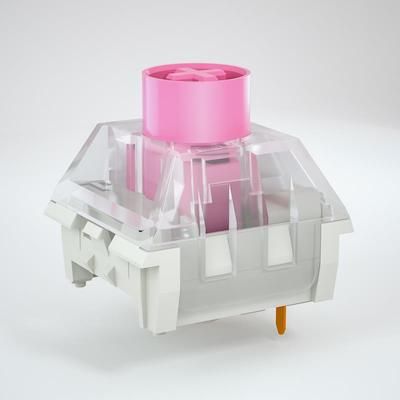
- Activation Force - 35g
- Bottom Out Force - 45g
- Activation - 1.8mm
- Travel - 3.6mm
Overall, the Kailh Box Silent Red is not as smooth as the other Kailh Box designs, with the Red or Speed Silver offering a smoother feel with a similar activation force.
Kailh Speed Silver
The Kailh Speed Silver has a smoother feel than the Kailh Box switches and the reduced activation and travel result in faster in-game response times. The activation force is also slightly higher than the Cherry MX, being 50g compared to 45g. I did not notice that this was too light, but I have found 35g switches (such as the Gateron Clear) to be far too light for gaming or typing. However, this does depend upon how hard you press the keys and if you lift off early or bottom out the keys.
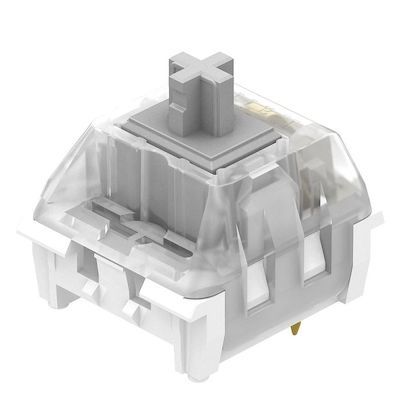
- Activation Force - 50g
- Bottom Out Force - 55g
- Activation - 1.1mm
- Travel - 3.5mm
Kailh Tactile Key Switches
Tactile key switches are popular for typing as they offer a noticeable tactile bump when pressed and have little noise. The tactile bump allows typists to achieve higher typing speeds as they are aware of the point the switch activates and can therefore remove their finger and move to the next key.
| Key Switch | Activation Force | Activation | Travel |
|---|---|---|---|
| Kailh Brown | 50g | 1.9mm | 4mm |
| Kailh Box Brown | 50g | 1.8mm | 3.6mm |
| Kailh Silent Brown | 45g | 1.8mm | 3.6mm |
| Kailh Pro Purple | 50g | 1.7mm | 3.6mm |
| Kailh Speed Copper | 50g | 1.1mm | 3.5mm |
Kailh Brown
The Kailh Brown is non-RGB and is not as good as switches from Cherry MX or Gateron with a slightly scratchy feel. I recommend the Kailh Box Brown instead.

- Switch Type - Tactile
- Activation Force - 50g
- Bottom Out Force - 60g
- Activation - 1.9mm
- Travel - 4mm
Kailh Box Brown
The Kailh Box Brown is a fantastic tactile switch. It has a firmer tactile bump than the Gateron Brown and is smoother than either the Gateron or Cherry MX Brown.
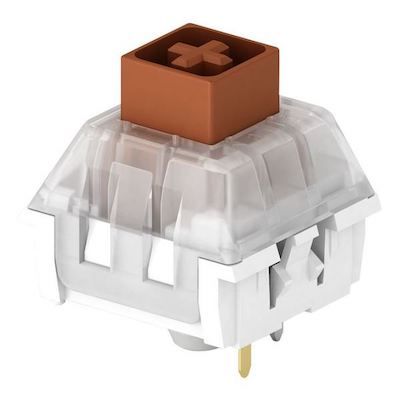
- Switch Type - Tactile
- Activation Force - 50g
- Bottom Out Force - 60g
- Activation - 1.8mm
- Travel - 3.6mm
Kailh Silent Brown
Whilst these have a lower sound they also have a lower tactile bump which is disappointing. They feel similar to the Gateron Brown that also has a low tactile feel.
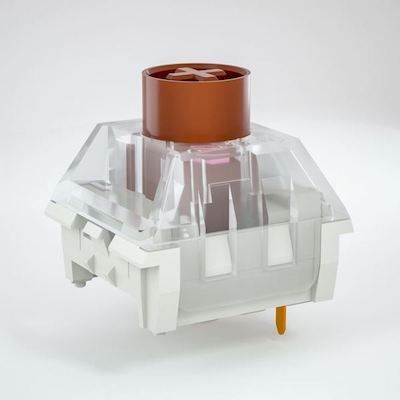
- Switch Type - Tactile
- Activation Force - 45g
- Bottom Out Force - 65g
- Activation - 1.8mm
- Travel - 3.6mm
With a similar internal design to the Cherry MX Silent Red, the switch includes a rubber dampener to reduce noise when they bottom out. Unlike Kailh Box switches, these feature a stem that is a circular shape rather than a box. This did not seem to introduce any more or less keycap wobble.
Kailh Pro Purple
Even though these are Pro switches, I did not find them to be as smooth as the Box or Speed switches. They have quite a wobbly feel, especially compared to the Kailh Box switches. They have a good tactile bump right at the start of the key press and feel more linear for the rest of the key travel. They have a stiffer spring towards the end of the keystroke, similar in feel to the Kailh Heavy switches and are quite difficult to bottom out. One thing I do like with the Pro Purple is the sound. They have a nice reassuring thud when pressed, a richer sound than the Box Brown. They have often been labelled a poor cousin to Zealios switches, especially the 65g and 67g versions. I prefer to think of them as having a unique feel. If you are a light typist and do not regularly bottom out your keys, these are a fantastic switch. If you are a heavy typer you may not enjoy their feel when they bottom out.
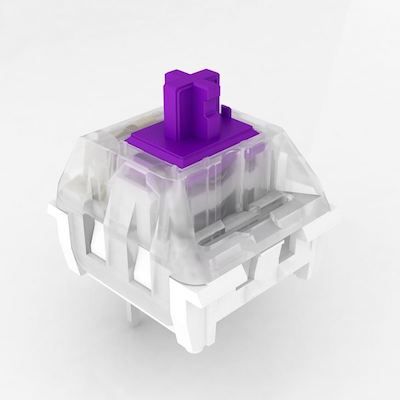
- Switch Type - Tactile
- Activation Force - 50g
- Bottom Out Force - 70g
- Activation - 1.7mm
- Travel - 3.6mm
I prefer the Kailh Box switches over the Pro switches for typing feel and response.
Kailh Speed Copper
Similar in feel to the Box Brown. They do not feature the box design so there is a slight bit of keycap wobble.
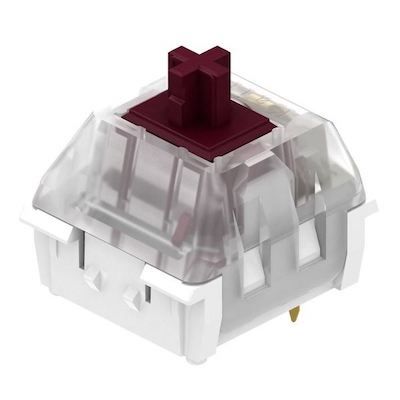
- Switch Type - Tactile
- Activation Force - 50g
- Bottom Out Force - 60g
- Activation - 1.1mm
- Travel - 3.5mm
Kailh Clicky Key Switches
Traditional clicky key switches are either loved or hated. Typists love the feel and tactile click that brings a classic typewriter feel to typing. However, it seems everybody else hates the loud noise they generate, especially in open environments. I highly recommend you try them out first. I can honestly say that I would love to swap out my Gateron Browns for the Kailh Box Whites, but I typically work from home in an open area and it would drive the rest of the family insane.
| Key Switch | Activation Force | Activation | Travel |
|---|---|---|---|
| Kailh Blue | 50g | 1.9mm | 4mm |
| Kailh Box White | 50g | 1.8mm | 3.6mm |
| Kailh Box Heavy Glazed Green | 50g | 1.8mm | 3.6mm |
| Kailh Box Heavy Pale Blue | 60g | 1.8mm | 3.6mm |
| Kailh Box Jade | 50g | 1.8mm | 3.6mm |
| Kailh Box Noble Yellow | 65g | 1.8mm | 3.6mm |
| Kailh Box Navy | 75g | 1.8mm | 3.6mm |
| Kailh Box Heavy Blue | 95g | 1.8mm | 3.6mm |
| Kailh Speed Bronze | 50g | 1.1mm | 3.5mm |
| Kailh Speed Gold | 50g | 1.4mm | 3.5mm |
Kailh Blue
The Kailh Blue is non-RGB and is not as good as switches from Cherry or Gateron and has a slightly scratchy feel. I recommend the Kailh Box White instead.
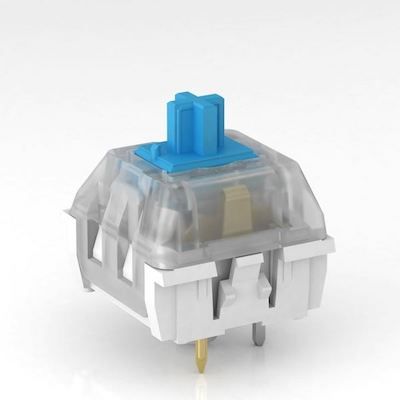
- Switch Type - Clicky
- Activation Force - 50g
- Bottom Out Force - 60g
- Activation - 1.9mm
- Travel - 4mm
Kailh Box White
The Kailh Box White features a click bar design and makes it a fantastic clicky switch. Cherry MX switches feature a click jacket design, and the general opinion seems to favour the click bar design. The click bar results in a nice crisp double-click sound. It is a smooth sounding click and with a medium activation and bottom-out force is a pleasure to type on.
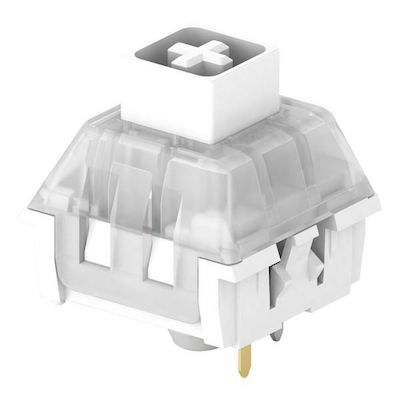
- Switch Type - Clicky
- Activation Force - 50g
- Bottom Out Force - 60g
- Activation - 1.8mm
- Travel - 3.6mm
Kailh Box Heavy Glazed Green
Released in 2019, the Glazed Green is a recent addition to the Kailh Box range of switches.
A member of the ‘heavy’ series, and like the Heavy Pale Blue switch, these have a progressively heavier feel towards the end of the key travel due to the spring design. The low bottom-out force in the specifications can be deceptive as they feel heavier than the Box White that, on paper, should be heavier. This is one reason I recommend trying out several key switches before. Cheap key switch testers are available on eBay.
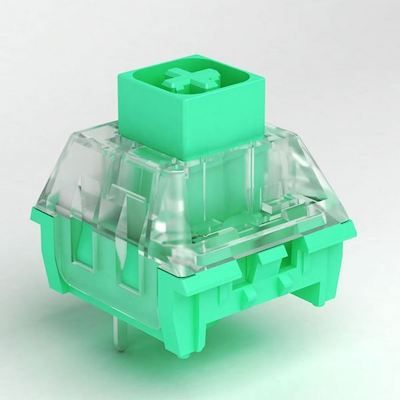
- Switch Type - Clicky
- Activation Force - 50g
- Bottom Out Force - 50g
- Activation - 1.8mm
- Travel - 3.6mm
Kailh Box Heavy Pale Blue
These have a slightly heavier activation force than the Box White. Interestingly they feel heavier than the 60g specification. This is because whilst the activation force is 60g, the bottoming out force is 80g. Many switches only have a 0g to 10g higher bottoming out force, providing a pretty consistent feel across the keystroke. The Box Heavy switches feel progressively heavier towards the end of the key travel. This gives a sharper click feeling, offering a more satisfying feel when typing.
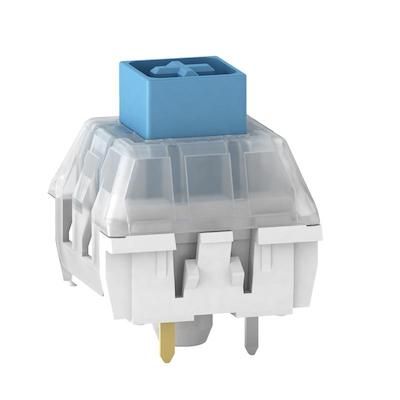
- Switch Type - Clicky
- Activation Force - 60g
- Bottom Out Force - 80g
- Activation - 1.8mm
- Travel - 3.6mm
Kailh Box Jade
The Kail Box Jade features a thicker click bar than the Box White resulting in a louder sound than other Box switches. The click bar results in a nice crisp double-click sound. They have a similar feel to the Kailh Box White.
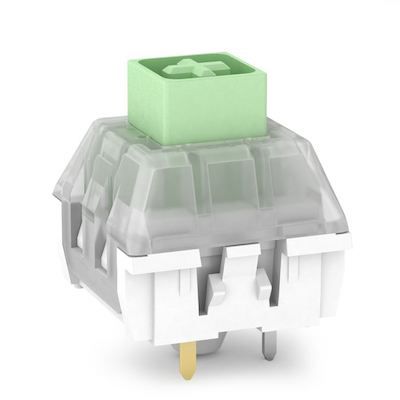
- Switch Type - Clicky
- Activation Force - 50g
- Bottom Out Force - 60g
- Activation - 1.8mm
- Travel - 3.6mm
Kailh Box Noble Yellow
Released in 2019, the Noble Yellow is a recent addition to the Kailh Box range of switches.
Even though they have a smooth feel and a nice tactile bump, they do not sound as good as either the Box White or Box Jade and have a slightly rattly metallic sound.
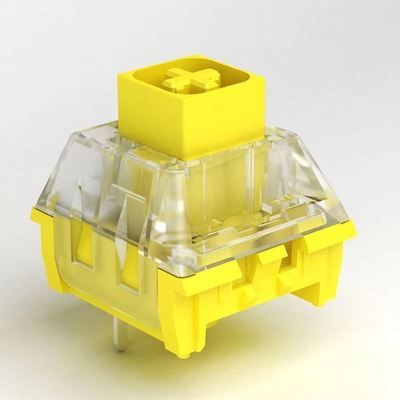
- Switch Type - Clicky
- Activation Force - 65g
- Bottom Out Force - 65g
- Activation - 1.8mm
- Travel - 3.6mm
Kailh Box Navy
Similar to the Kailh Box Jade, these feature a thicker click bar to produce a louder sound. They have a slightly heavier feel to the Box White. As the activation and bottom-out force is the same, they have quite a linear feel when pressed, without an increase or decrease in feel throughout the keypress.
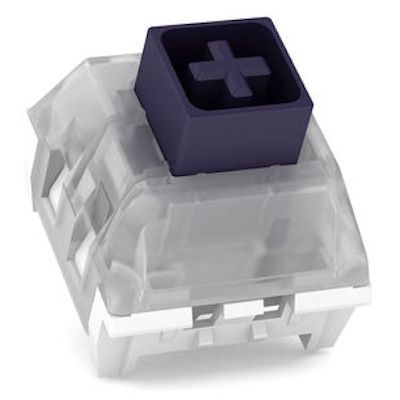
- Switch Type - Clicky
- Activation Force - 75g
- Bottom Out Force - 75g
- Activation - 1.8mm
- Travel - 3.6mm
Kailh Box Heavy Blue
Even though they are called blue, the stem is a dark grey colour. I guess Kailh are running out of names considering they have released so many switches! Keeping to their name, they have a very heavy activation and bottom-out force. I found these too heavy for fast typing.
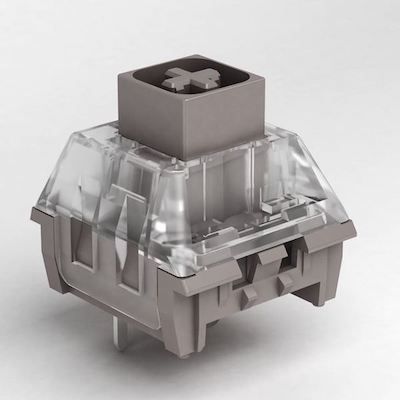
- Switch Type - Clicky
- Activation Force - 95g
- Bottom Out Force - 100g
- Activation - 1.8mm
- Travel - 3.6mm
Kailh Speed Bronze
Similar in feel to the Box White. However, they feature a click jacket design that means the click does not sound as crisp as the click bar designs. Therefore I prefer the Kailh Box White or Box Jade. They do not feature the box design so there is a slight bit of keycap wobble.
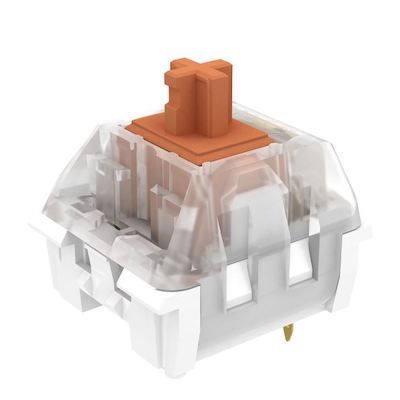
- Switch Type - Clicky
- Activation Force - 50g
- Bottom Out Force - 65g
- Activation - 1.1mm
- Travel - 3.5mm
Kailh Speed Gold
Similar in feel to the Box White. However, they feature a click jacket design that means the click does not sound as crisp as the click bar designs. Therefore I prefer the Kailh Box White or Box Jade. They do not feature the box design so there is a slight bit of keycap wobble. They have slightly more activation travel than the Speed Bronze, somewhat halfway between the Speed Bronze and the Box Brown.
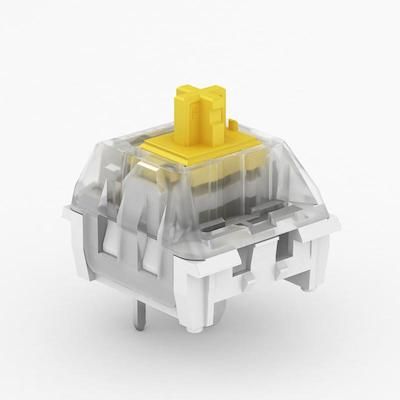
- Switch Type - Clicky
- Activation Force - 50 g
- Bottom Out Force - 60g
- Activation - 1.4mm
- Travel - 3.5mm
How to Choose Keyboard Key Switches?
There are several factors to consider when looking to choose the type of mechanical key switch for your next keyboard.
Work (or Play) Environment
When considering the type of key switch you need to be aware of the environment where you will be doing the most typing or gaming. If it is in a home office, bedroom or gaming room, you may be less worried about a noisy keyboard. If in an open environment then consider the noise of clicky switches and the people around you.
Key Feel
The choice of the key switch will also depend on how you like the keyboard to feel. Moving to a mechanical key switch opens up a wide range of different styles, from a smooth feeling keystroke, one that has an obvious tactical bump or a defined noisy click.
Usage
Another deciding factor would be your specific usage.
- Gaming - If you are predominantly using the keyboard for gaming, I would recommend a linear key switch. They offer a smooth keystroke and are silent. Most gaming keyboards include a Red key switch.
- Typing - If you will be mainly typing then either a tactile or clicky keyboard is recommended. The choice will come from the level of noise you can accept and the specific feel. The popular DAS Keyboards offer a choice of either Cherry MX Brown or Blue.
- General Purpose - The reason the tactile Brown is the most popular key switch is that it offers a nice middle ground between a smooth linear switch and a noisy clicky one. I am a longtime fan of tactile switches as they can be using for both gaming and typing, and I find that having a switch that caters well to both is preferred.
Conclusion
Being able to choose between key switches is a great advantage of choosing a mechanical keyboard. Kailh offers some of the best quality and best value key switches and is highly recommended if you are choosing a new mechanical keyboard or if you are looking to upgrade the switches in your existing keyboard.
